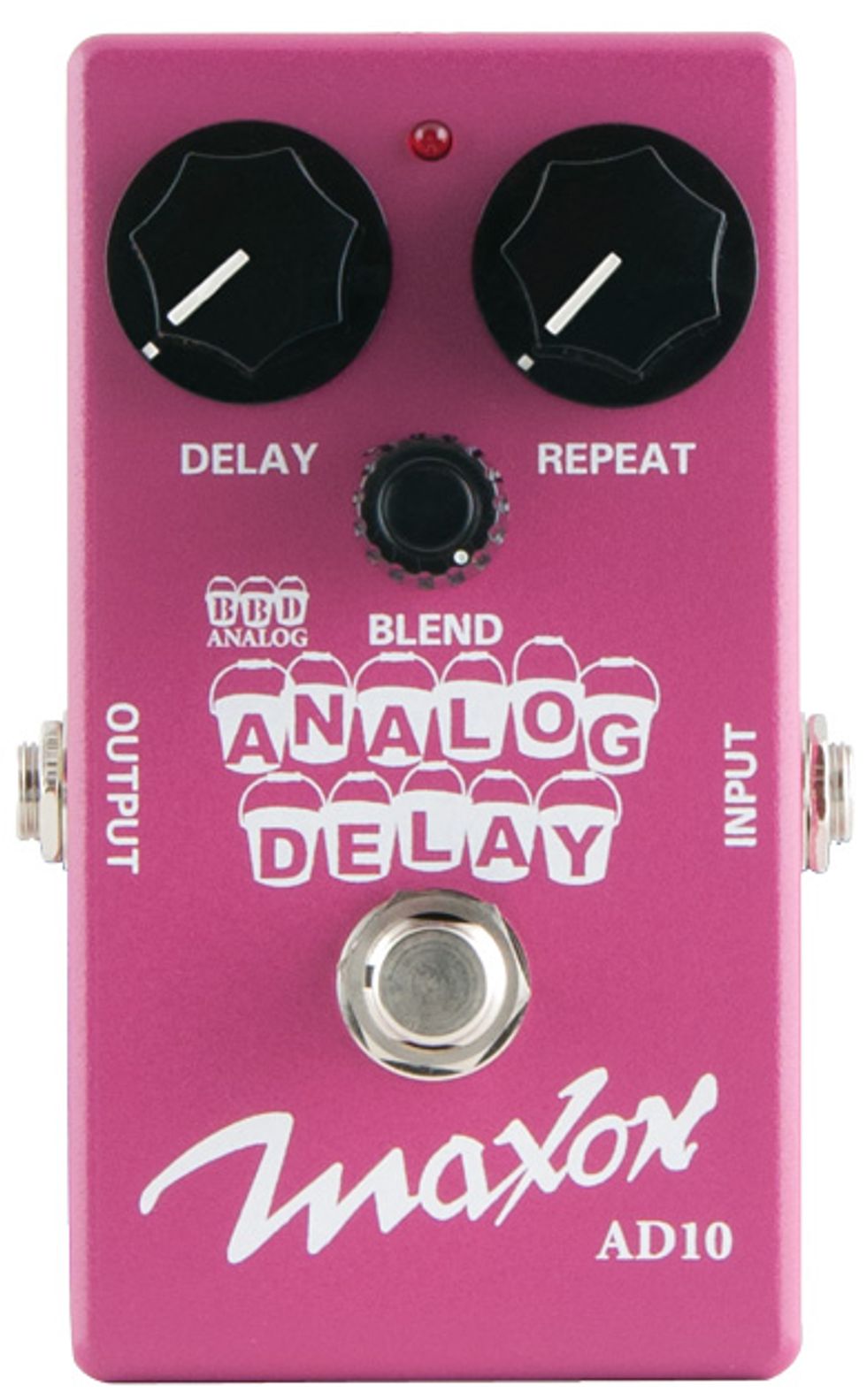Though Maxon is a fixture in the stompbox hall of fame—at least among dedicated circuit nerds—the company did its most famous work in the shadow of Ibanez, which rebranded the TS808, TS9, and AD9, making them classics in the process. If those three pedals were all Maxon ever built, the company would be legendary. But despite a relatively low profile, Maxon has consistently reissued vintage circuits (with new-old-stock components), as well as new stompboxes. One of the newest is the AD10, an analog delay that uses time-tested BBD (bucket-brigade device) technology to achieve its natural, mellow repeats.
Purple Echo Maker In terms of size, the Maxon AD10 is more akin to an old TS808 and more compact than an AD9. The white-on-purple-flake graphics include a visual pun alluding to the bucket-brigade circuit within. The control set is classically simple: Delay increases the space between each repeat up to 600 ms—a pretty decent gap for a compact analog delay. Turning the repeat knob fully counter-clockwise yields a single-note slapback, while full clockwise settings produce infinite self-oscillation. The blend knob controls the mix between your wet/dry signal.
BBD technology was developed in the late ’60s and became the foundation for many great analog, time-based effects. In brief, the signal is run through a series of capacitors. As it moves through the circuit, the signal degrades ever so slightly and becomes progressively more distorted, which gives good BBD circuits their unique, organic tone.
Deep Inside the Echo Chamber Analog delays routinely find their way onto rockabilly pedalboards, thanks to their dark, slapback sound. The original Boss DM-2 and Ibanez AD9 are highly sought after for this reason. Dialing up this coveted delay flavor was simple with the AD10: I just rolled off the repeat, pegged the delay around noon, and kept the blend fairly high. My Fender Twin’s spring-reverb tank was a great match for this sound too. And if you have a good reverb, you should use it liberally with the Maxon at these settings—it really plays into the AD10’s ample strengths.
Ratings
Pros:
Robust repeats with a lush trail.
Cons:
Price is probably a bit much for casual players.
Tones:
Playability/Ease of Use:
Build/Design:
Value:
Street:
$249
Maxon AD10 Delay
maxonfx.com
I love pairing analog delays with single-coil axes. There’s something about the low-output and strong treble content of single-coils that couples so nicely with a darker delay and makes for a perfect tone marriage. The AD10’s warm, long delay sounded great with my Fender guitars, and both my Twin Reverb and Orange OR50 added a real layer of musicality to the more extreme delay settings.
Compared to a lot of proven analog delay circuits, the Maxon AD10 lets you stand out better in a full band mix. Its midrange is more focused, but because it also offers the pleasant, dirty chime of an analog delay, your tone retains a lot of character. The AD10 is even a hair cleaner than a vintage Boss DM-3 and has a more swirling trail.
The Verdict The Maxon Analog Delay AD10 retails for a whopping $249. That’s a lot for a single—and pretty simple—effect. That said, it’s exceptionally well built and sounds fantastic. Vintage purists will note you could probably track down a vintage AD9 or DM-3 for the same price. But the AD10’s performance, in many cases, matches or betters that of those two classics, and you get a new—and potentially less problematic—device. The bottom line is that you get what you pay for, and the AD10 is, by any standard, a great sounding analog delay that’s likely to stay among your frontline echo units for years to come.













![Rig Rundown: Russian Circles’ Mike Sullivan [2025]](https://www.premierguitar.com/media-library/youtube.jpg?id=62303631&width=1245&height=700&quality=70&coordinates=0%2C0%2C0%2C0)





